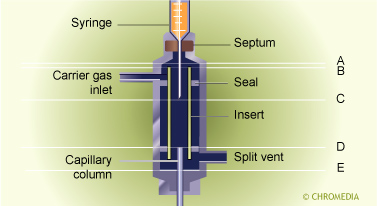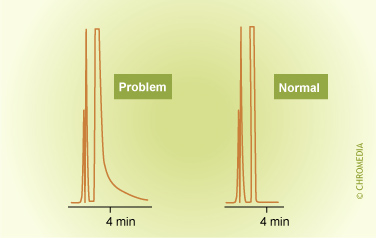LevelBasic
Appropriate insertion length injector (split)
The insertion depth of a column into the injector is crucial for optimum separation results. Many problems can be encountered if the column does not have the appropriate ![]() insertion depth in the liner.
insertion depth in the liner.
Although the depth of insertion depends on type of liner and injector geometry, a general approach is:
- Position A: The column is installed as far as the septum. In this case there are two major problems:
- The carrier gas cannot enter the column.
- The syringe needle can damage the column or the column can damage the needle.
A fused silica column will probably break. With a steel column, the column and the needle can bend.
- Position B: In this position the carrier gas does flow through the column.It is comparable to position A and produces the same poor results.
- Position C: The sample is injected close to the column opening.
This can lead to overloading. In particular with injection of liquids, discriminating effects can be observed. The sample must be introduced in the column as a vapor. If the column opening is too close to the needle tip, high boiling compounds do not have enough time to vaporize.
Effect of dead volume on peak shape
A very large portion of the sample will be transported beyond the column opening by the carrier gas towards the split line. Only a small portion can find its way on to the column due to the evaporation explosion. The result is that, due to this back diffusion, the injection is not instantaneous and can therefore lead to broad or tailing peaks. In addition to a large discrimination effect (high boiling compounds more than low boiling compounds) and distorted peaks, the injection is non-reproducible.
- In position D the column opening is beyond the split opening. A too large a portion of the sample is split. A low split ratio could offer a solution, but the amount of carrier gas and the amount of sample solvent would then give problems.
- The only correct installation of the capillary column is position E. The column protrudes slightly above the insert outlet and is far enough from the needle opening. In practice an insert length of 1 cm above the bottom of the insert is recommended.
 Did you ever try to explain separation to your employees or students? Well, try no more: Lee Polite did it for you in a way which is hard to beat. We will open up one example of his whiteboard class.
Did you ever try to explain separation to your employees or students? Well, try no more: Lee Polite did it for you in a way which is hard to beat. We will open up one example of his whiteboard class. 




